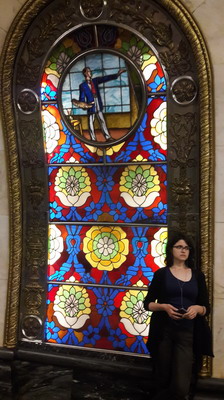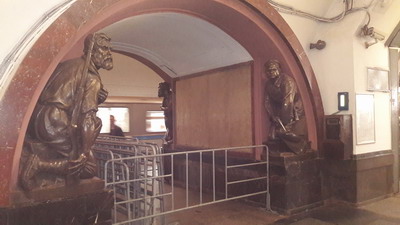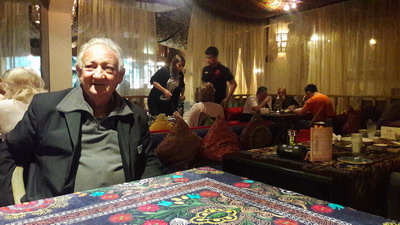
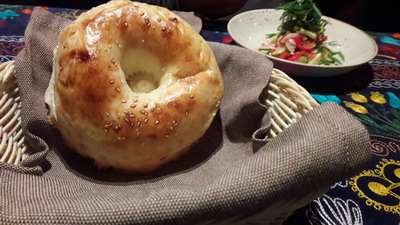
We thought we had mentally prepared ourselves for Moscow by agreeing that we should expect a 3rd world country from the service point of view. We were, however, still surprised by an hour’s wait at passport control. And then, as we left the Arrivals Hall, we were confronted by men wearing tags that said ‘Official Taxi’. Seeing no other signs pointing to a taxi stand, after some haggling we managed to bring down the price with the help of a young woman wearing Mickey Mouse ears who said that ordering through Uber Taxi was much cheaper. After a long walk we arrived at an unmarked car, rather dusty. I balked and didn’t want to go inside. The driver, seeing my suspicions, announced: “Business Class.” Running my finger along the dusty outside and snorting ‘business class’ was of no help and we were bundled inside. As we left we saw a long line of yellow cabs waiting to pick up passengers. Even with a GPS the driver twice tried to let us off at the wrong hotel.
By this stage all
we wanted was a quiet dinner and some sleep. Following
the receptionist’s advice to eat at a nearby Uzbekistan restaurant, we,
without
much hope of a decent meal, traversed a parking lot, some garages and
an
all-male club, Virgin’s Club, promising pole dancing. Our fears were
immediately dispersed when we entered Uryuk Restaurant. They didn’t
speak
English but welcomed us warmly. The restaurant was partitioned off by
gauzy
material into cubicles, but they led us to the main area which was
richly
decorated, from ceiling to floor, by carpets and woven throws. We
declined the offer to sit on the lounging sofas and
chose a table with an interesting woven tablecloth. A waiter who spoke
a little
English came and helped us choose food, including delicious crispy
round bread, hot beetroot soup, perfectly prepared grilled denise and
an
Uzbekistan
pilaf-style dish. All in all a delightful relaxed evening with good
food.


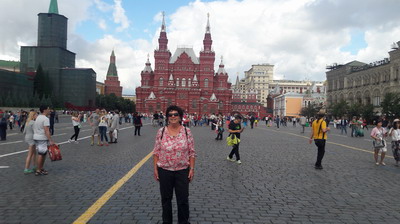
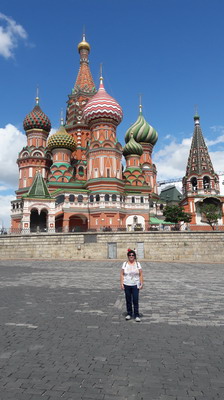
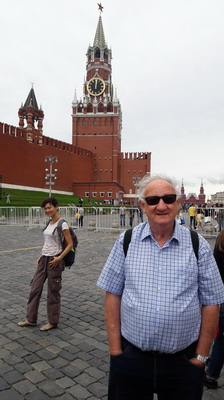
We crossed over to the Gum building instead. It is not a department store but three enormous arcades three stories high with boutique stores and coffee shops, toilets (a necessity by this time), an historic toilet and as we were later informed, the tourism bureau.
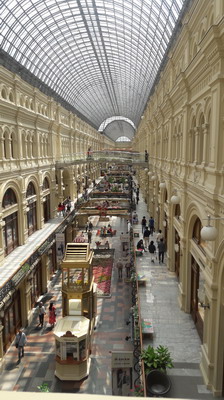

That evening, smartly dressed (Dad
even wore a tie!) we went to the Bolshoi
Theatre.
A number of years ago
we attended the Bolshoi ballet in St. Petersburg
and were disappointed, but this evening was magical. The theatre itself
is
impressive; the whole building is richly decorated, and in the main
hall the
ceiling towers above six tiers. We sat in the orchestra just below the
royal
box. While we were enjoying the formal dress of the people, a very tall
woman
with a neckpiece of encrusted stones extending over her shoulders and
up her
long slender neck entered. When she sat in front of me I saw that her
hair was
gathered into a bun that sat high above her head, completely blocking
any view
of the stage. Thankfully, she reluctantly agreed to change places with
her son.
(After that, whenever we saw someone with a topknot we joked that they
were on
the way to the ballet.)
The ballet being
performed was Balanchine’s Jewels,
unusual in that it is a three part ballet without a storyline. The
jewels were
emeralds, rubies and diamonds and the costumes and stage reflected the
jewels.
Each part was very different, giving the dancers a chance to show their
skills;
Diamonds was Russian ballet at its very best.
That evening looking out of our hotel window we enjoyed a fine view. In the distance the tall imposing building is one of the Seven Sisters, skyscrapers built during the Stalin era and today housing the Foreign Ministry, Moscow University, an hotel and apartment blocks. Circling the city they would also appear to have been a powerful reminder of Soviet power.
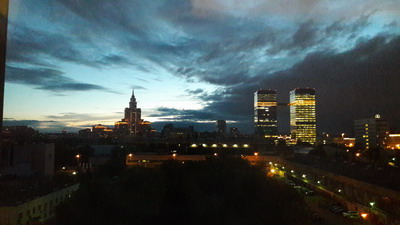
The next morning we joined a free walking tour that was both informative and interesting. We were surprised by the amount of building activity around the city. It seems there are two reasons. The one is that Moscow is snow-free for only 6 months of the year, so all building needs to be done during the summer months. The other reason is that in 2018 Moscow will host the FIFA World Cup. That explains the number of stadia that are being built, with work continuing around the clock. The Russian Orthodox Church is flourishing in Moscow; there are some 600 churches many of them lovingly restored. We also learnt that Cyrillic is named after St. Cyril. He and his brother St. Methodius devised the basis for the Russian alphabet in order to translate the bible into a language that the Slavs could read.
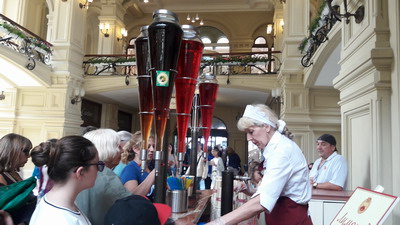
During
a
quick stop at Gum we were delighted to see a woman making fancy gazoz.
For our grandchildren: when we first came to Israel there was no coca
cola nor
other soft drink that we are familiar with today. But at a kiosk you
could buy
gazoz: different flavored syrups with soda water from a metal sypholux.
After the tour we made
a long hike in the heat through lots of road
construction up Tverskaya ulitsa, one of the main shopping streets, to
a
sumptuously decorated delicatessen, Yeliseyevsky Food Hall, that is
situated in a former aristocrat's home. The
interior of the shop was grandiose although the contents, besides
outrageously
expensive Beluga caviar and Beluga vodka, unremarkable. If this was the
home
of a
wealthy Russian at the time of the tzars, one can only imagine in what
luxury
the tzars themselves lived.
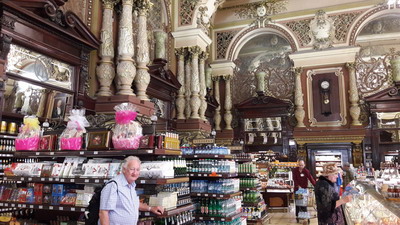
That evening we made our way to Café Pushkin. A guard in the
metro
had told us to go up the stairs and walk straight, but coming out of
the metro
we were not sure how to proceed, whether to turn sharply left or cross
the road
to the other side. No-one spoke English and all were unhelpful. After
crossing
the road (straight) and walking for about 10 minutes we finally got the
idea
that something was wrong. When we asked some people they could only
shake their
heads unable to direct us in the right direction. We finally hailed a
taxi who
drove and drove. Something was definitely wrong. Anthony again showed
him the
address, this time in Russian. He again GPS-ed it, turned around and
after 5
minutes dropped us at the metro exit where we had pondered 30 minutes
prior. He
pointed past some construction and a minute later we were in
Café Pushkin, a
delightful 18th century house.
The food was excellent and what a
pleasure it was that the accompanying classical music was played by
four young women
dressed in white and obviously enjoying themselves
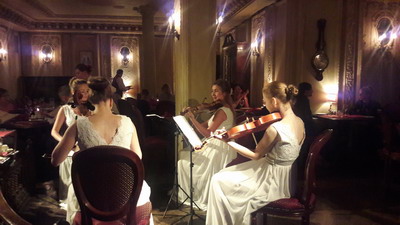
I took a picture of the wooden toilet seat in order to tell my grandchildren that my grandfather (of whom I have no memory unfortunately) was a wood turner. Before the advent of plastic he made egg cups, vases, headboards of beds, and toilet seats. He won prizes for his work and cousins tell me that his eye was so exact that he never had to measure anything.
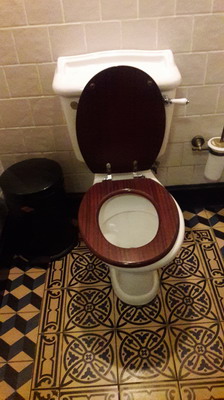
On our last day my
plan to visit the museums was abandoned because
museums are closed on Mondays; so no Russian icons, Faberge eggs or
fabulous
diamonds. Instead we made our way to the Choral Synagogue, the main
Moscow
synagogue. Incised in my memory is the visit of Golda Meir to the
Moscow
synagogue in 1948. When we visited Cuba in the 1990’s we were told that
under
communism there are no telephone books. I’d imagine that it was the
same
Moscow. But somehow news of Golda's visit was passed around and not
only
was the
synagogue packed but also the street outside. It was an amazing display
of
identification at a time when religion was seriously frowned upon.
Today at
the
entrance to the synagogue is a flashy modern mezuzah, brought by
Netanyahu on
his visit earlier this year (2016). Happily
Choral is a functioning synagogue and the
guide’s
voice could hardly be heard above the groups of men studying on either
side of
the main hall.
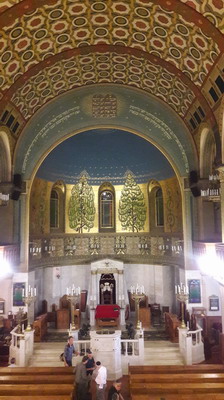

We walked to St
Basil’s Cathedral. Although the guide books name
each of the many domes, inside it is like a maze of tiny churches and
quite impossible
to know where you are. Although interesting, it is much more impressive
from
the outside. We continued to the square
by the main metro station and watched as people stood on a metal circle
by
Resurrection Gate and threw money over their shoulders. We shall never
know if
it was for good luck or for ensuring eternal life. Whatever the reason
it was a
source of income for two women who quickly picked up the coins as they
fell to
the floor. We looked for the barbecue stalls, but it seems there had
been an
ice-cream festival and all the ice-creams stalls and barbecues had all
been
dismantled. We stopped at Bar BQ café
instead. Before we even
tasted the food
we saw that we had made a most fortunate choice. The owners of the
restaurant have
founded the Tigrus Fund and work towards the preservation of the
endangered Amur
snow tiger. They donate food towards feeding boars and deer that are
the food
of the tigers. Certain dishes on the menu have a little tiger next to
them. The
markup on these items goes toward the tiger fund. Of course we choose
those
items and sent a picture to our granddaughter Lotem who is crazy about
tigers. A
welcome addition was that the food was tasty.
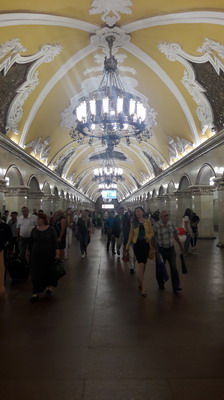 On
our frequent use of the metros we could not help remarking on the
beauty of the underground metro stations. We
joined a metro tube tour which we highly recommend.
On
our frequent use of the metros we could not help remarking on the
beauty of the underground metro stations. We
joined a metro tube tour which we highly recommend. Not only does Anthony
love
undergrounds but I have a very clear memory of my mother enthusing
about the
Moscow metros. That takes a little explaining. My mother was an
intrepid
traveler who, with her friend Toby Kahn, visited Russia at what must
have been
the height of the Cold War. How she managed this must unfortunately
remain a
mystery. There are only two stories that I remember her telling us. The
one was
when she and her friend booked an overnight train (to somewhere). While
they
were preparing for bed a man walked into their compartment to claim his
bunk
for the night. My mother literally
pushed him out and locked the door. His enraged shouting and the
banging of the
carriage warden could not persuade my mother to open the door. The
other story
embedded in my mind is her amazement at the Moscow metros where
chandeliers
hung from the ceilings. Even today they are unique and worth visiting.
So for
me this tour was paying homage to her memory. (I also ate a lot of
smetana, a
kind of sour cream, to honour my father!)
Today there are 14
different lines (with a 15th to be
inaugurated soon), with over 200 stations that transport over 7 million
people
daily. Trains arrive every 1-2 minutes.
The
oldest stations are deep under the ground with very long escalators
with a
person sitting in a booth at the bottom in case of emergencies. They
are very
spacious and clean. Despite the lack of English, once you get the hang
of it –
and don’t forget to count the stations as the names of the stations are
not
prominently displayed – they are very convenient to use. It was Stalin
who
instructed the building of the first metro, overriding fierce
opposition;
Nikita Khrushchev was one of the upcoming communists who oversaw the
construction. The metros were, as our
guide
put it, to be palaces for the proletariat showcasing the achievements
of the
people and giving expression to the different professions and trades of
Soviet
society. The Red Army, communist youth and men and women from all over
the
Soviet Union were drafted to help build the metros. Each metro has a
different
theme, including larger than life statues, frescoes, marble, granite,
steel, even stained glass windows and
always chandeliers. The oldest stations
were used as bomb shelters when the Nazis in 1941 were at Moscow’s
door, posing
a real threat of overpowering the city. The metros became the
headquarters of
the anti-aircraft defense. They were used at night as living spaces
with beds,
hospitals, libraries and youth clubs. Stalin’s
death in 1953 brought an end to the terrible terrorization of the
people
through purges and executions. After that Stalin’s image was removed
both in
the metro system and outside of it and replaced with that of Lenin,
seen as the
great founder not only of communism, but the modern Russian nation.

